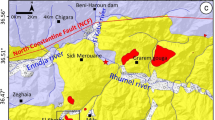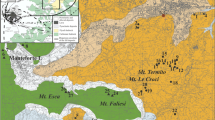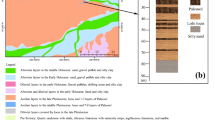Abstract
The Iwate-Miyagi Nairiku Earthquake in 2008 triggered a complex debris slide—earth flow on the east slope of Mt Hikagemori, Kurihara city, Miyagi prefecture. In situ surveys 6 days after the occurrence revealed that the earth flow body was mostly unsaturated, but near the slip surface pore fluid pressure was built up with suspension of fine soil particles. From undrained cyclic loading triaxial compression tests on undisturbed samples taken from the head scarp of the landslide, a measured cohesion was at least 50 kPa, and a structural collapse could take place in a case. In mass flow experiments by means of a large-scale model flume, an unsaturated mass moved and slid smoothly over the muddy water travelling a long distance for a specimen with sufficient water inside. This may not reproduce the exact fluidisation behaviour of the complex Hikagemori landslide, though it may also explain a part of the long travelling mechanisms of the Hikagemori landslide.
Access provided by Autonomous University of Puebla. Download conference paper PDF
Similar content being viewed by others
Keywords
1 Introduction
The Iwate-Miyagi Nairiku earthquake in 2008 occurred in the south of the inland of Iwate Prefecture at 8:43 JST, 14 June 2008 (Mj = 7.2), triggering many landslides (debris slides, debris flows, rock falls, etc.) largely in Miyagi and Iwate Prefectures. The authors visited the landslide sites 6 days after the occurrence, finding long-travelling flow-type of landslides could be grouped into two: usual debris flows in which debris was saturated with water; and, earth flows and debris flows in which earth and debris were not saturated. Mechanisms of long travelling motion and fluidisation found in an unsaturated earth flow on the east slope of Mt Hikagemori, Kurihara city, Miyagi Prefecture is reported in this paper with results of triaxial compression tests and mass flow experiments by means of a large-scale model-flume.
2 The Complex Hikagemori Landslide (Debris Slide-Earth Flow)
The Hikagemori landslide is a complex type (debris slide-earth flow) generated on the east slope of Mt Hikagemori in Miyagi Prefecture (Photo 45.1). The Hikagemori debris slide occurred on a slope having a cap-rock structure: welded tufa underlain by unwelded pumiceous tufa. The width of the head-scarp was about 75 m, the height was about 20 m (Photo 45.2), the debris-slide-mass moved in a rotating mode and little disturbance was found in the main body. The width of deposition of debris slide was about 120 m and a slip surface was formed within the unwelded pumiceous tufa. Most of the soil stopped after moving about 20 m, however, a left-part of them moved down the concave slope, fluidised on the course travelling more than 150 m. Photo 45.1 is the result of compass surveying, showing the longitudinal section of deposition area, runout area of the earth flow and left-part of debris slide (about 10 m inside from the left-flank). It was a very gentle slope (smaller than 10°) on the earth flow deposition area. However, at the final edge of the earth flow deposition area, a relatively steep slope was formed at about 25° (Photo 45.3). Also a sediment of fine soil particles was found, where muddy water exuded around from the slip surface and fine particles settled. The sediment was about 10 mm high (Photo 45.4), it expanded about six metres ahead. In the earth flow deposition and run-out areas, it was not found that the soil mass was saturated, indicative that the soil mass probably moved down under the unsaturated conditions. While, based on the formation of the thin layer of the fine soil particles’ sediment, it was assumed that fine soil particles suspended within the pore-fluid near the slip surface, building-up an excess pore-fluid pressure. When the earth flow mass stopped, pore-fluid pressure reduced and fine soil particles exuded forming a thin layer of sediment. In addition, it should be mentioned that a part containing much water was found in the run-out area. At that part, the soil easily liquefied when vibrated by foot (Photo 45.5).
3 Triaxial Compression Tests
In order to examine fluidisation mechanisms, undrained triaxial compression tests were conducted. Undisturbed specimens were sampled with 100-ml tubes (0.05 m high) from the head-scarp. The cylindrical-shape specimen was trimmed to be 0.1 m high and 0.05 m in diameter in the laboratory. A mean soil particle size (D 50 ) = 0.32 mm, a uniformity coefficient (U c ) = 18.9 (D 10 = 0.028 mm, D 60 = 0.53 mm), soil particle density (ρ s ) = 2,662 kg/m3. Under 15 kPa confining stress, the specimens were saturated under the 0.3 m water-head-difference for three to 12 h. After consolidation, axial load was applied in sinusoidal wave form 30 times at 1 Hz under undrained conditions. When the specimen did not fail, further 30 waves were applied, in which the amplitude of the waves were enlarged (Table 45.1). The loading was stopped when the axial strain reached 15 %.
An effective stress path of test-TTA is shown in Photo 45.2. Since the specimen had low pore pressure coefficient B (Skempton 1954), neither pore-water pressure build-up nor abrupt reduction of shearing resistance was observed. A failure envelope was observed, an internal friction angle was about 18° and a cohesion was as much as 60 kPa. Also in test-TTB, pore-water pressure build-up and abrupt reduction of shearing resistance were not found. An effective stress path of test-TTC which had the largest void ratio of the three is shown in Photo 45.3. When the amplitude of the axial load was small, it was not observed the pore-water pressure build-up and abrupt reduction of shearing resistance. However, given the larger axial load, abrupt reduction of shearing resistance was observed, in which large pore-water pressure build-up was not found. This would be probably attributable to a collapse of soil skeletal structure taking place during stain softening behaviour. This fact proved that abrupt reduction of shearing resistance due to the collapse could take place under certain conditions of void ratio, the degree of saturation, and stresses.
4 Mass Flow Experiment by Means of Large-Scale Model-Flume
In order to investigate the long travelling behaviour of the Hikagemori earth flow, mass flow experiments using a large-scale model-flume were conducted on a disturbed sample taken from the head-scarp of the Hikagemori landslide. Details of the large-scale model-flume (Photo 45.4) are found in Okada and Ochiai (2008). It is totally 13 m long, 1 m deep, and 0.6 m wide, and consists of two parts: the inclination of the upper part can be varied from 10 to 45°, while the lower part is horizontal. Specimens (0.6 m3) were set in the upper end portion of the inclined segment (1 m long) and retained by a water-proof casement gate. The water proof casement gate was controlled electronically to release the specimen at the start of each experiment run. Roughness was provided on the bottom surface of the flume by placing a sheet on which 0.4–2.0 mm sand grains were sprayed. Pressure transducers were set in the base of the flume to measure basal fluid pressure, and laser displacement transducers were positioned above them to measure normal flow depth. These data were logged by a PC at 500 Hz. In addition, the movement of the material was monitored by digital video cameras (60 fps). Four time-code indicators were set around the flume to show the elapsed time with a resolution of one hundredth of a second. The digital video cameras were situated so that they could film the time-code indicators. Using this system, the basal fluid pressure, the normal flow depth data, and the filmed images could be synchronised.
Although high pore-fluid pressure was probably built-up near the slip surface, most of the earth flow body assumed to be unsaturated conditions. Then, a specimen was saturated only in the bottom half in the first experiment (Ex-FEA). When releasing the material on a slope of 30°, the material decelerated even on the inclined portion and the main body deposited only 2.5 m downslope from the water-proof gate. Pressure heads measured on the base of the flume did not exceed the normal flow depth. A cohesion of the specimen should be reduced based on the scaling of the model flume (Kagawa 1978), however, it was difficult. Because the cohesion was not reduced in the experiment, it likely worked too much and prevented the material from travelling downslope further. An equivalent coefficient of friction was 0.545.
In the second experiment (Ex-FEB), water was percolated for 3.5 h through whole specimen to be saturated. In this case, pressure head measured at position 1 (Photo 45.4) exceeded normal flow depth between 27 and 27.5 s (Photo 45.5). During this period, higher basal pore-fluid pressure was likely built-up. Whereas, pressure head remained negative between 30 and 36 s. This was probably due to an insufficient saturation of the specimen even though water was slowly percolated for 3.5 h.
Some parts of the material deposited on the inclined portion, but some parts travelled long distance up to 6.6 m ahead from the connection of the inclined portion and horizontal portion. Filmed images revealed that the unsaturated mass moved and slid on the muddy water, and finally deposited (Photo 45.6). This mass positioned at near the head when moving down the inclined portion, then, after reaching the connection of the inclined and horizontal portions, it travelled further splitting off during the movement. Muddy water insisted that the fine soil particles were suspended in the water, and a higher apparent density of the fluid resulted in generation of higher basal fluid pressure. An equivalent coefficient of friction of Ex-FEB was only 0.256, a high mobility was reproduced in the experiment of the specimen with sufficient water inside.
Although the experiments were conducted by means of the large-scale model flume, it was revealed that the long travelling behaviour was difficult for the sample with the high cohesion to be reproduced especially in Ex-FEA. While, a long travelling behaviour was observed in Ex-FEB, in which the unsaturated mass moved and slid on the muddy water. This may not explain the exact mobility of the Hikagemori earth flow, it may also insist that the mass will travel long distance when the slip zone is saturated and high pore-fluid pressure reduces the shearing resistance.
5 Concluding Remarks
The Hikagemori landslide triggered by the Iwate-Miyagi Nairiku Earthquake in 2008 was a complex type: debris slide-earth flow. The slope of earth flow toe was at least 25°, fine soil particles exuded around from the surface of separation. These suggested that most of the mass was unsaturated but near the slip surface high pore-fluid pressure was built-up with suspension, resulting in the long travel distance. Undrained triaxial compression tests revealed that cohesion was at least 50 kPa, reduction of shearing resistance due to collapse of soil skeleton structure would take place in a case. Mass flow experiments showed that unsaturated mass moved and slid on the muddy water travelling the long distance in the experiment of the specimen with sufficient water inside. This may explain a part of the long travelling mechanisms of the Hikagemori landslide.
References
Kagawa T (1978) On the similitude in model vibration tests of earth-structures. Proc Jpn Soc Civil Eng 275:69–77
Okada Y, Ochiai H (2008) Flow characteristics of 2-phase granular mass flows from model flume tests. Eng Geol 97:1–14
Skempton AW (1954) The pore pressure coefficients A and B. Géotechnique 4:143–147
Author information
Authors and Affiliations
Corresponding author
Editor information
Editors and Affiliations
Rights and permissions
Copyright information
© 2013 Springer-Verlag Berlin Heidelberg
About this paper
Cite this paper
Okada, Y., Kurokawa, U., Asano, S. (2013). Examining Fluidisation Mechanisms of Hikagemori Landslide Triggered by Iwate-Miyagi Nairiku Earthquake in 2008 by Laboratory Soil Tests. In: Ugai, K., Yagi, H., Wakai, A. (eds) Earthquake-Induced Landslides. Springer, Berlin, Heidelberg. https://doi.org/10.1007/978-3-642-32238-9_45
Download citation
DOI: https://doi.org/10.1007/978-3-642-32238-9_45
Published:
Publisher Name: Springer, Berlin, Heidelberg
Print ISBN: 978-3-642-32237-2
Online ISBN: 978-3-642-32238-9
eBook Packages: Earth and Environmental ScienceEarth and Environmental Science (R0)









